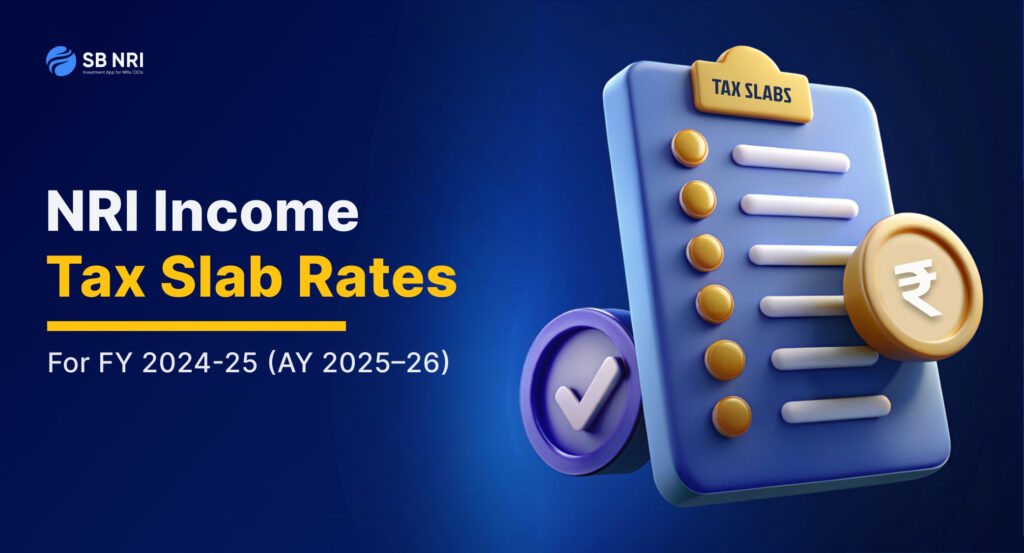
Living abroad but earning in India? You’re not alone. Whether it’s rent from your flat in Mumbai, dividends from Indian stocks, or capital gains from selling property, any income sourced from India is taxable here – even if you’re physically miles away. To understand taxes better, you need to understand the NRI Income Tax Slab Rates.
Let’s break it down simply:
If you’re a Non-Resident Indian (NRI) earning income in India, understanding your income tax slabs is crucial. In this blog, we’ll walk you through:
- Which tax slabs apply to NRIs?
- Which tax regime to choose: Old vs New?
- Do surcharges, cess, and marginal relief apply to NRIs?
- What about deductions and rebates?
- Is foreign income taxable in India?
Discover & Claim Your TDS Refund in 2 Minutes
Let’s get started.
Who is an NRI for Tax Purposes?
First things first – are you even considered an NRI under Indian tax laws?
As per Section 6 of the Income Tax Act, you’re treated as a Non-Resident Individual if:
- You stayed in India for less than 182 days during the financial year
OR - You stayed in India for less than 60 days during that year AND less than 365 days in total over the past 4 years.
Note: If you’re an Indian citizen visiting India and your total Indian income exceeds ₹15 lakh, this threshold changes to 120 days (instead of 60 days).
Is Foreign Income Taxed in India?
This one’s simple. If you’re an NRI, your foreign income isn’t taxed in India. You’ll only pay Indian tax on income that:
- Is earned in India, or
Arises or accrues in India, or - Is received directly in India.
For example:
- Rental income from Indian property
- Dividends from Indian companies
- Interest on Indian bank deposits
- Capital gains from selling Indian shares or property
All these are taxable in India.
Got Foreign Income as an NRI? Here’s How to Report It in India (or Not!)
Which ITR Form Should NRIs Use?
- ITR-2 – If you don’t have any business income in India.
- ITR-3 – If you earn from a business or profession in India.
Filing an Income Tax Return (ITR) is mandatory if your total Indian income crosses ₹2.5 lakh in a financial year – even if tax has already been deducted at source (TDS).
NRI Income Tax Slab Rates for AY 2025–26
From FY 2023–24, the New Tax Regime (Section 115BAC) has become the default tax regime for NRIs. But you can still choose the Old Regime if you prefer.
NRI Income Tax Slab Rates: Old Tax Regime
If you can claim deductions under 80C, 80D, housing loan interest, etc., the old regime might work better for you.
| Income Slab (₹) | Tax Rate | Surcharge |
| Up to 2,50,000 | Nil | Nil |
| 2,50,001 – 5,00,000 | 5% of amount above ₹2,50,000 | Nil |
| 5,00,001 – 10,00,000 | ₹12,500 + 20% of amount above ₹5,00,000 | Nil |
| 10,00,001 – 50,00,000 | ₹1,12,500 + 30% of amount above ₹10,00,000 | Nil |
| 50,00,001 – 1,00,00,000 | Same as above | 10% |
| 1,00,00,001 – 2,00,00,000 | Same as above | 15% |
| 2,00,00,001 – 5,00,00,000 | Same as above | 25% |
| Above 5,00,00,000 | Same as above | 37% |
NRI Income Tax Slab Rates: New Tax Regime (Default)
For many NRIs, especially those with limited deductions in India, the New Regime might be simpler.
| Income Slab (₹) | Tax Rate | Surcharge |
| Up to 3,00,000 | Nil | Nil |
| 3,00,001 – 7,00,000 | 5% of amount above ₹3,00,000 | Nil |
| 7,00,001 – 10,00,000 | ₹20,000 + 10% of amount above ₹7,00,000 | Nil |
| 10,00,001 – 12,00,000 | ₹50,000 + 15% of amount above ₹10,00,000 | Nil |
| 12,00,001 – 15,00,000 | ₹80,000 + 20% of amount above ₹12,00,000 | Nil |
| 15,00,001 – 50,00,000 | ₹1,40,000 + 30% of amount above ₹15,00,000 | Nil |
| 50,00,001 – 1,00,00,000 | Same as above | 10% |
| 1,00,00,001 – 2,00,00,000 | Same as above | 15% |
| Above 2,00,00,000 | Same as above | 25% |
Important Things NRIs Must Know:
- No Rebate under Section 87A:
NRIs are not eligible for the rebate that makes income up to ₹7 lakh (under New Regime) or ₹5 lakh (under Old Regime) tax-free for residents. - Standard Deduction:
The ₹75,000 standard deduction is allowed only if you have Indian salary income. - Cess Applies in Both Regimes:
A 4% Health & Education Cess applies on your total tax plus surcharge. - Surcharge Limit on Capital Gains:
The maximum surcharge on long-term capital gains (LTCG), certain short-term capital gains, and dividends is capped at 15%.
What Is Marginal Relief for NRIs?
If your income crosses ₹50 lakh, ₹1 crore, ₹2 crore, or ₹5 crore, a surcharge applies. But to prevent your tax from suddenly spiking, Marginal Relief ensures:
- Your total tax + surcharge doesn’t exceed the tax payable on the exact threshold (₹50 lakh, ₹1 crore, ₹2 crore, ₹5 crore) by more than the amount of income that exceeds that threshold.
Example?
If your income is ₹50,10,000, the additional ₹10,000 shouldn’t cause your total tax to jump by ₹1 lakh due to surcharge. Marginal relief softens such spikes.
Old vs New Regime: Which Is Better for NRIs?
Choose the Old Regime if:
- You have deductions in India like:
- Life insurance premiums (Indian policy)
- Home loan repayments (principal and interest)
- Health insurance premiums
- Tuition fees in India
- Contributions to Indian PPF, NSC, ELSS, etc.
Choose the New Regime if:
- You don’t have major deductions in India.
- You prefer a simpler structure with fewer compliances.
Do I Still Need to File ITR If TDS Is Deducted?
Yes. Even if your bank, tenant, or mutual fund house deducts TDS, you should file your return:
- To declare total income
- To avoid notices
- To claim refunds if excess TDS was deducted
You can track TDS via Form 26AS and AIS on the Income Tax Portal.
What About Double Taxation?
If you’re taxed in India and your resident country on the same income, DTAA (Double Taxation Avoidance Agreement) can help. You may:
- Claim a tax credit in your resident country for taxes paid in India
- Or claim an exemption in India, depending on the treaty
Always retain proof of tax paid in India to avail DTAA benefits abroad.
Summary: NRI Tax Slabs at a Glance
- The New Regime is default for NRIs from FY 2023–24.
- NRIs don’t get ₹7 lakh or ₹12 lakh rebate.
- Deductions allowed only if you opt for the Old Regime.
- File ITR even if TDS is deducted.
- Only Indian income is taxed; foreign income isn’t.
- Watch out for surcharge and cess.
Conclusion
NRIs often feel disconnected from India’s tax system, but understanding where your income fits in the NRI Income Tax Slab Rates can save you from overpaying taxes—or ignoring your obligations.
Remember:
- Check your residential status each year.
- Choose your tax regime wisely.
- File your ITR to stay compliant and claim refunds.
When in doubt, consult a tax advisor familiar with NRI taxation to simplify the process.

FAQs on NRI Income Tax Slabs and Filing
1. Do NRIs need to file income tax returns in India every year?
If your total Indian income exceeds ₹2.5 lakh in a financial year, filing an ITR is mandatory – even if tax (TDS) has already been deducted on your income.
2. Are NRIs eligible for the ₹7 lakh rebate under the New Tax Regime?
No. The rebate under Section 87A (which makes income up to ₹7 lakh tax-free for residents) does not apply to NRIs.
3. Which ITR form should NRIs use to file returns?
- ITR-2: If you do not have any business or professional income in India.
- ITR-3: If you earn from a business or profession based in India.
4. Is foreign income taxable in India for NRIs?
No. Only income earned, received, or accrued in India is taxable for NRIs. Your salary earned abroad or income from foreign investments stays tax-free in India.
5. How can NRIs avoid double taxation?
Through the Double Taxation Avoidance Agreement (DTAA). You can either claim a tax credit in your resident country for taxes paid in India or get an exemption in India, depending on the agreement between both countries.
6. Can NRIs continue using their resident savings account?
No. After becoming an NRI, you should convert your resident savings account into an NRO account for Indian earnings and open an NRE account for foreign remittances.
7. Do NRIs have to pay capital gains tax in India?
Yes. If you sell property, shares, or mutual funds in India, any capital gains are taxable here. TDS is usually deducted at the time o



